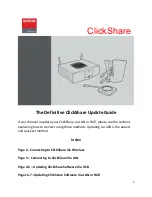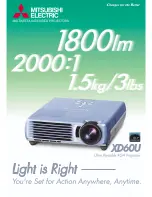
Appendix
Connecting Pin Assignments
RS-232C Port:
9-pin D-sub male connector of the DIN-D-sub RS-232C cable
Pin No.
Signal
Name
I/O
Reference
1
Not connected
2
RD
Receive Data
Input
Connected to internal circuit
3
SD
Send Data
Output
Connected to internal circuit
4
Reserved
Connected to internal circuit
5
SG
Signal Ground
Connected to internal circuit
6
Reserved
Connected to internal circuit
7
Reserved
Connected to internal circuit
8
Reserved
Connected to internal circuit
9
Not connected
6 7 8 9
1 2 3 4 5
INPUT 2 COMPONENT/RGB Port:
15-pin Mini D-sub female connector
RGB Input
Pin No. Signal
1
Video input (red)
2
Video input
(green/sync on green)
3
Video input (blue)
4
Not connected
5
Composite sync
6
Ground (red)
7
Ground (green/sync on green)
Pin No. Signal
8
Ground (blue)
9
Not connected
10
Ground
11
Ground
12
Bi-directional data
13
Horizontal sync signal
14
Vertical sync signal
15
Data clock
Component Input
Pin No. Signal
1
Video input P
R
(C
R
)
2
Video input Y
3
Video input P
B
(C
B
)
4
Not connected
5
Not connected
6
Ground (P
R
)
7
Ground (Y)
Pin No. Signal
8
Ground (P
B
)
9
Not connected
10
Not connected
11
Not connected
12
Not connected
13
Not connected
14
Not connected
15
Not connected
Downloaded From projector-manual.com Sharp Manuals
(RS-232C) Specifications and Command Settings
• If an underbar (_) appears in the parameter column, enter a space.
P
P
I
I
I
I
O
O
V
V
V
V
W
W
E
E
E
E
R
R
D
D
D
D
_
_
_
_
_
_
_
_
_
_
_
_
_
_
_
_
_
_
1
0
1
2
3
4
BUTTONS & REMOTE CONTROL BUTTONS
Downloaded From projector-manual.com Sharp Manuals
Dimensions
Units: mm
Front View
Bottom View
Side View
Top View
Side View
Rear View
Downloaded From projector-manual.com Sharp Manuals
Glossary
Aspect ratio
Width and height ratio of an image. The normal aspect ratio of a computer and video image is 4 : 3. There are also wide images with an aspect ratio of 16 : 9
and 21 : 9.
Auto Sync
Optimises projected computer images by automatically adjusting certain characteristics.
Background
Initial setting image projected when no signal is being input.
Clock
Clock adjustment is used to adjust vertical noise when clock level is incorrect.
CLR Temp (Colour temperature)
Function that can be used to adjust the colour temperature to suit the type of image input to the projector. Decrease the colour temperature to create warmer,
reddish images for natural flesh tones, or increase to create cooler, bluish images for a brighter picture.
Composite sync
Signal combining horizontal and vertical sync pulses.
Digital keystone correction
Function to digitally correct a distorted image when the projector is set up at an angle, smoothes out jaggies on keystone images and compresses the image
not only horizontally but vertically keeping the 4 : 3 aspect ratio.
Digital shift
Shifts image up or down easily by
/
buttons when RESIZE mode of input image is NORMAL, BORDER, or STRETCH of COMPUTER, VIDEO and DTV
inputs.
GAMMA
Image quality enhancement function that offers a richer image by brightening the darker portions of the image without altering the brightness of the brighter
portions. You can select from four different modes: Standard, Black Detail, White Detail and Brighten.
Intelligent compression and expansion
High quality resizing of lower and higher resolution images to fit the projector’s native resolution.
Phase
Phase shift is a timing shift between isomorphic signals with the same resolution. When phase level is incorrect, the projected image typically displays horizontal
flicker.
RESIZE
Allows you to modify or customize the picture display mode to enhance the input image. You can select from four different modes: NORMAL, FULL, BORDER
and STRETCH.
RS-232C
Function to control the projector from the computer by using the RS-232C ports on the projector and computer.
Stretch
Mode that stretches the 4:3 image horizontally to display it on the wide screen.
Sync on green
Video signal mode of a computer which overlaps horizontal and vertical sync signal to green colour signal pin.



































